The Snake River, a majestic waterway weaving its way through the Pacific Northwest, boasts a rich tapestry of biodiversity. From its diverse fish population to its namesake reptiles, the river teems with life. Yet, beyond its beauty and ecological significance, questions arise. What lies within these waters? And is it safe to dip in for a swim?
Unraveling these answers requires an exploration of the river’s contents, its pollution levels, and the impact of human activities on its health. It also calls for an understanding of the other potential hazards within this river ecosystem, which plays a role in determining its safety for swimming.
In this article, we delve deep into these aspects, painting a comprehensive picture of what’s in the Snake River and addressing the all-important question: is it safe to swim in?
Overview of the Snake River
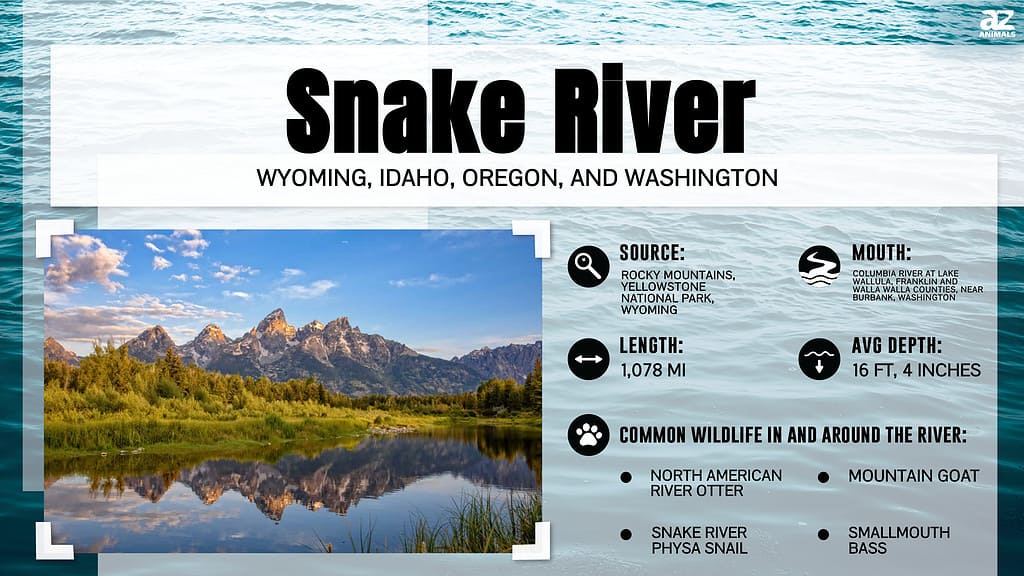
High up in the Rocky Mountains, in the wilderness of Yellowstone National Park, Wyoming, the Snake River has its humble beginnings. As one of the major arteries of the Pacific Northwest, it stretches over 1,078 miles. Quickly leaving its birthplace in Wyoming, it winds its way into Idaho, defining the Idaho-Oregon and Idaho-Washington borders. Its journey culminates in Washington State, where it serves as a vital tributary to the Columbia River.
Notable Landmarks

The sun sets on Oxbow Bend of Snake River in Wyoming’s Tetons.
©Krishna.Wu/Shutterstock.com
Breathtaking landmarks adorn the journey of the Snake River. One such spectacle is the Hells Canyon. Formed by the erosive action of the river over millions of years, this is the deepest river gorge in North America, surpassing even the Grand Canyon in depth. Additionally, the river boasts the Shoshone Falls, often referred to as the “Niagara of the West.” At 212 feet, this waterfall eclipses the height of the renowned Niagara Falls, presenting an impressive display of the river’s power and beauty.
Climate and Geographic Features
The Snake River traverses through diverse climates and landscapes. In its upper stretches, it flows through cold, semi-arid, and alpine climates. Further downstream, it transitions into arid and semi-arid regions. This diverse climate range significantly influences the flora and fauna along its course.
The geographic impact of the Snake River is substantial. It has shaped the region’s geography in multiple ways: creating fertile floodplains conducive to agriculture, forming marshlands that serve as a haven for numerous bird species, and cutting deep canyons into the earth’s surface.
Fish in the Snake River
Dive deeper into the Snake River, it’s a buzzing aquatic hub teeming with diverse fish species. The river’s varied climate and water conditions, from the colder upper reaches to the warmer downstream sections, make it an ideal environment for many species.
Native Species
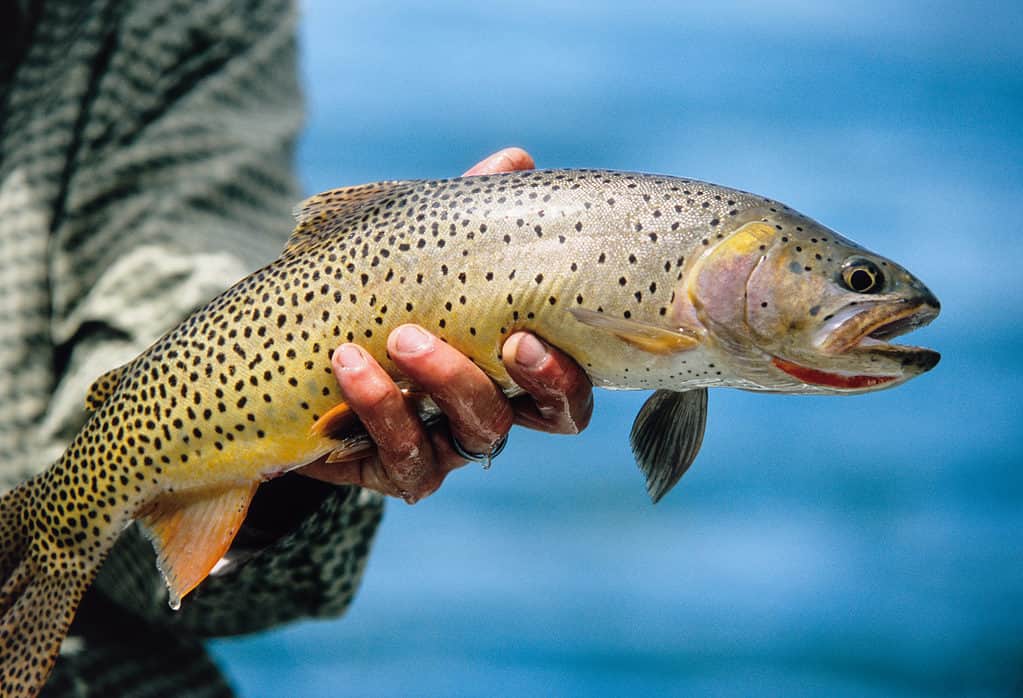
A cutthroat caught, then released on the South Fork of the Snake River, Swan Valley Idaho.
©iStock.com/KevinCass
Leading the native troop is the cutthroat trout. It thrives in the cool, clear waters, feeding on aquatic and terrestrial insects and smaller fish. Its reddish hue under the jaw earns it the “cutthroat” name.
Sharing the habitat are the Mountain Whitefish and Northern Pikeminnow. The Mountain Whitefish flaunts a slender, torpedo-shaped body, while the Pikeminnow, despite being often overlooked by anglers, plays a crucial role in the ecosystem by preying on other fish species.
Notably, the river shelters the bull trout, an iconic species protected under the Endangered Species Act. Their specific cold water habitat requirements make them a key indicator of ecosystem health.
Migratory Fish
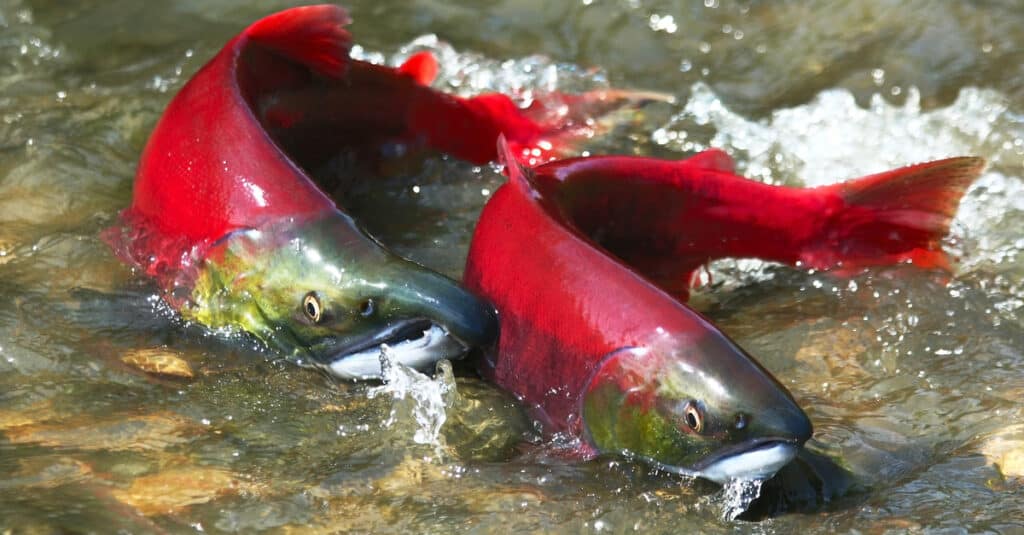
Sockeye salmon turn bright red during the spawning season.
©Vasik Olga/Shutterstock.com
Acting as a highway for migratory fish, the Snake River witnesses the epic journey of Pacific salmon. They start life in the river’s freshwater, migrate to the Pacific Ocean, and return to their birthplace to spawn and complete their life cycle.
Introduced Species
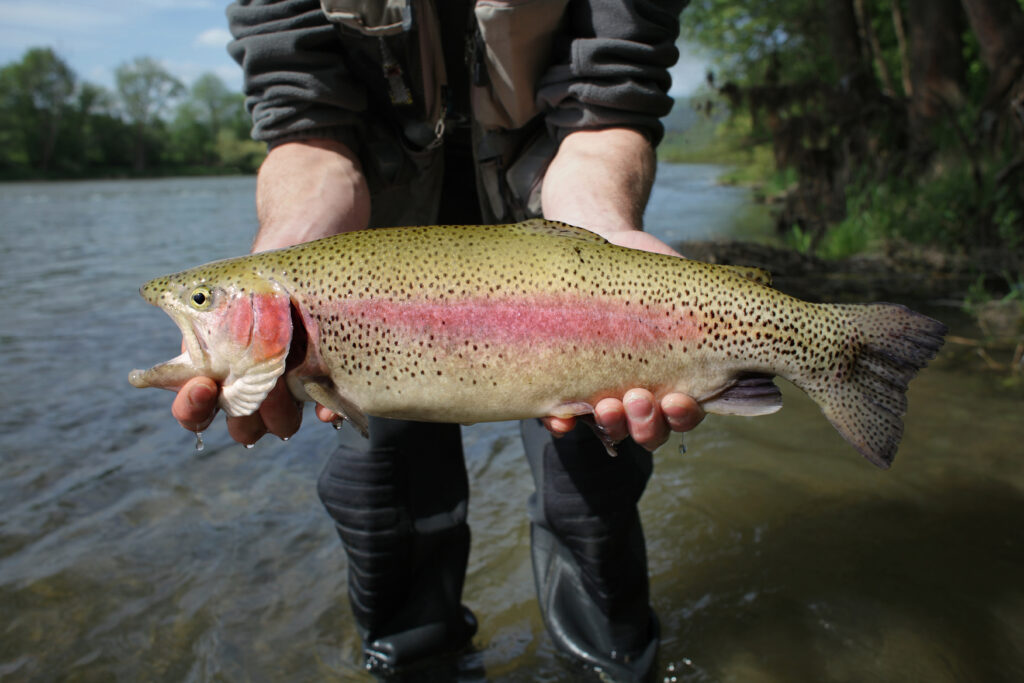
Anglers travel all over the Snake River searching for large rainbow trout to catch.
©pictoplay/Shutterstock.com
Beyond the natives and migrants, the Snake River also accommodates some guests. Rainbow trout and brown trout have made the river their home and significantly contribute to the local fishing economy.
Snakes in the Snake River
The Snake River isn’t teeming with its namesake creatures. However, a few species have been identified in and around this ecosystem. Each contributes to the river’s rich biodiversity in its own unique way.
Garter Snakes

Western terrestrial garter snakes are found in nearly all habitats, but most commonly at lower elevations around water like the Snake River.
©Hunter Kauffman/Shutterstock.com
Garter snakes, characterized by their distinctive longitudinal stripes, are the most common snakes near the Snake River. With high adaptability to different habitats, they make homes in various environments, including woodlands, marshes, and near water bodies. These snakes have a diverse diet, including fish and amphibians. By consuming these creatures, garter snakes help maintain a balanced ecosystem, preventing the overpopulation of their prey species.
Rattlesnakes
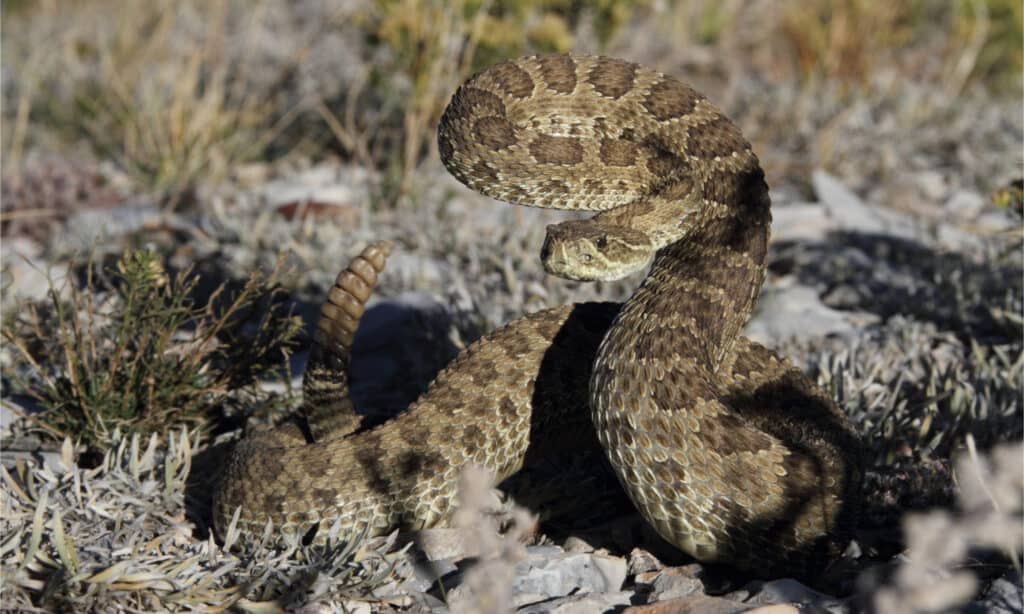
Prairie or western
rattlesnakes
are most commonly found in areas surrounding the Snake River.
©Harris Motion Photo/Shutterstock.com
Western rattlesnakes, with their distinctive rattle at the end of their tail, prefer drier and rocky areas surrounding the Snake River. They are typically nocturnal, seeking cover during the day and becoming active at dusk. As carnivorous predators, they play a significant role in controlling populations of small mammals and birds. Even though they pose a potential threat to humans due to their venom, their overall contribution to keeping the ecosystem in check is invaluable.
Rubber Boas
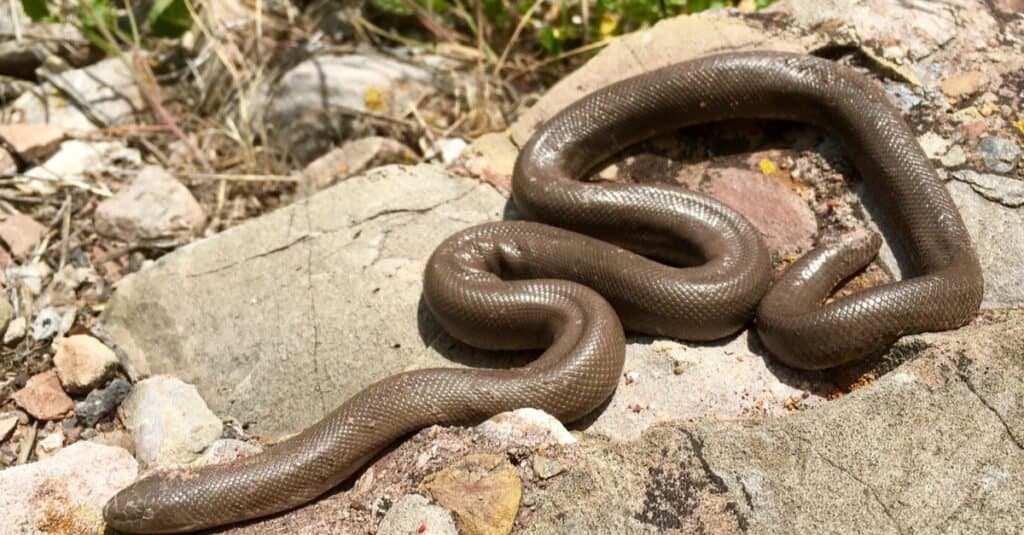
With the right kind of care, Rubber Boas can be kept as a pet.
©Matt Jeppson/Shutterstock.com
Rubber boas, named for their smooth, rubbery skin, are one of the more secretive residents around the Snake River. They prefer cooler climates and are often found in grasslands, forests, and near streams. Their nocturnal and secretive nature often makes them hard to spot.
Is the Snake River’s Water Polluted?
While the Snake River offers captivating natural beauty, there are concerning aspects of its health. Several sources contribute to the river’s pollution, affecting its water quality and the living organisms within it.
Agricultural Runoff
One primary source of pollution is agricultural runoff. Fertilizers and pesticides used in the vast farmlands surrounding the Snake River often find their way into the river, introducing harmful substances such as nitrates and phosphates. These substances can lead to excessive growth of aquatic plants and algae, a phenomenon known as eutrophication. This can deplete oxygen levels in the water, harming fish and other aquatic species.
Industrial Waste

Fossil fuels are a major contributor to pollution.
©iStock.com/Максим Шмаков
Industrial waste is another significant source of pollution. Factories and processing plants in the region sometimes discharge untreated or poorly treated waste into the river, adding heavy metals and other toxic substances to the water. These pollutants can accumulate in the tissues of aquatic organisms, posing risks to the entire food chain.
Urban Runoff
Urban runoff, especially from populated areas, can introduce a range of pollutants, from petroleum residues from roads to household chemicals. These pollutants can degrade water quality and pose threats to aquatic life.
Water Quality Monitoring and Concerns
Regular monitoring of the Snake River’s water quality has revealed elevated levels of certain pollutants at different times, raising concerns for the health of the river’s ecosystem and those who rely on it. It’s important to note that while measures are in place to manage and reduce pollution, the river’s health continues to be a point of concern.
The Snake River, with its diverse ecosystem, is a vital resource in the Pacific Northwest. However, pollution issues pose serious threats. The state of the river’s water quality serves as a reminder of the delicate balance that must be maintained to preserve this important waterway for future generations.
Other Hazards Within the Snake River
Beyond pollution and human activities, there are other hazards in the Snake River that can pose risks to humans and wildlife. Understanding these risks is essential for safely navigating and conserving this vital waterway.
Rapid Currents and Cold Water
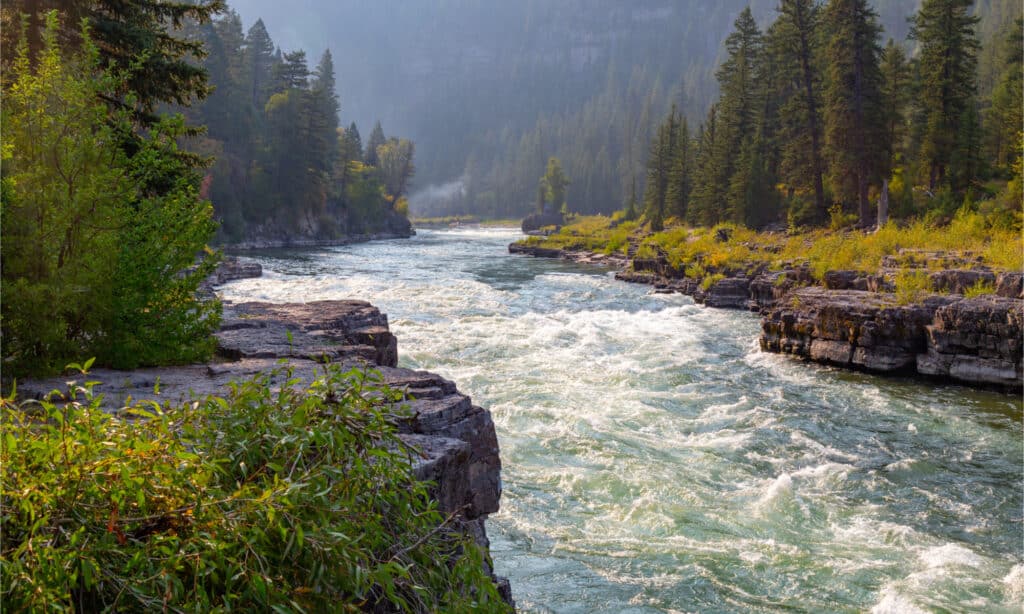
Strong currents run through the Snake River.
©CSNafzger/Shutterstock.com
One of the notable hazards in the Snake River is its rapid currents, particularly in certain sections of the river. These currents can quickly sweep away swimmers, boaters, or anglers, leading to potentially dangerous situations. Compounding the risk is the river’s temperature: the water, especially in the upper reaches and during certain times of the year, can be quite cold. This can lead to hypothermia if one is immersed for too long.
Dangerous Wildlife
While the wildlife in and around the Snake River contributes to its biodiversity, some species can pose hazards. These include venomous snakes like the Western Rattlesnake and large predators such as mountain lions and bears that inhabit the surrounding areas. Encounters with these creatures can pose risks if not handled properly.
Unpredictable Weather Conditions
Weather conditions in the Snake River region can change quickly and unexpectedly, posing another hazard for individuals venturing in and around the river. Rapid changes in weather can lead to unexpected storms, sudden drops in temperature, or foggy conditions that can reduce visibility.
Falling Rocks and Landslides

Landslides can cause major damage to people and the environment.
©iStock.com/TACrafts
In certain sections, the Snake River cuts through steep, rocky terrains. Falling rocks and landslides in these areas can pose hazards, both to individuals near the riverbanks and to boats navigating the river.
Despite these potential hazards, with proper precautions and respect for nature, the Snake River remains a cherished resource for recreation, wildlife habitat, and much more. However, awareness of these risks reinforces the need for responsible and informed use of this majestic waterway for the safety of all who rely on it and the protection of its ecological integrity.
Is It Safe to Swim in the Snake River?
The Snake River, with its clear waters and scenic surroundings, might seem like an inviting place to swim. However, a few important considerations come into play when determining its safety for swimming.
Water Quality
As previously discussed, pollution from agricultural runoff, industrial waste, and urban sources can affect the quality of the Snake River’s water. Depending on the time and location, the river can contain elevated levels of pollutants, potentially posing health risks for swimmers.
Currents and Water Temperature
The river’s fast currents and cold water, particularly in certain sections and times of the year, are other crucial factors to consider. Strong currents can lead to dangerous situations for swimmers, while cold water temperatures can increase the risk of hypothermia.
Wildlife Encounters
The possibility of encounters with wildlife, including venomous snakes or larger predators in the surrounding areas, is another safety aspect to keep in mind. Although these encounters are relatively rare, they can pose risks if they occur.
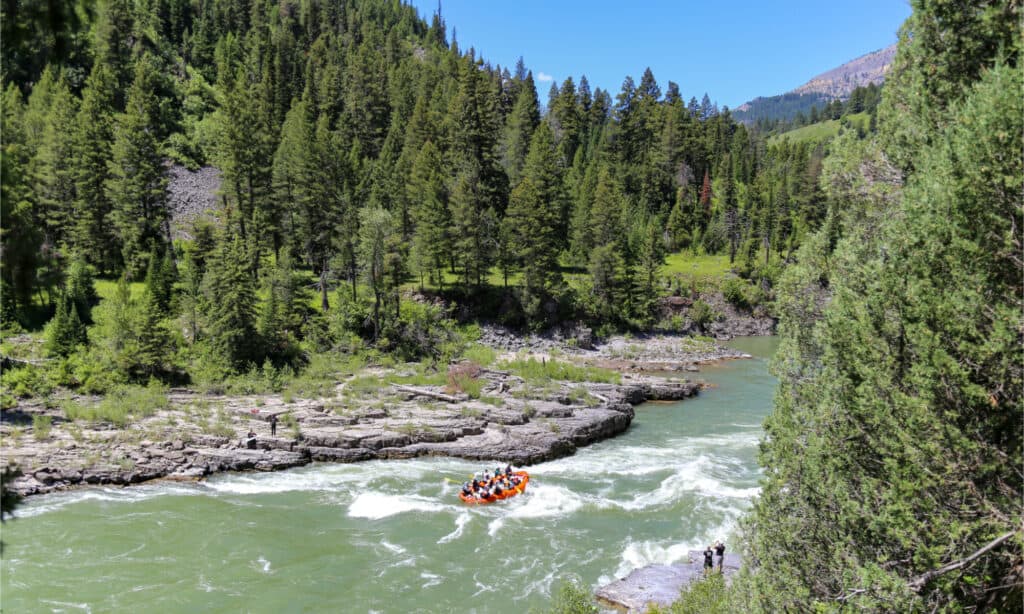
White water rafting is a popular activity to do on the Snake River’s strong currents.
©CSNafzger/Shutterstock.com
Despite these potential hazards, it is not impossible to safely swim in the Snake River. The key lies in understanding the risks and taking appropriate precautions. Swimmers should be aware of the water quality, current speed and temperature, and potential wildlife in the area. In addition, always follow local regulations and guidelines, which are designed to ensure safety and preserve the health of the river’s ecosystem.
Key Takeaways
From fish and snakes to the challenging impacts of pollution, the Snake River holds an intricate mosaic of life and challenges. It’s more than a river; it’s a living, dynamic ecosystem filled with beauty and potential hazards alike.
Is it safe to swim in the Snake River? The answer, as we’ve seen, depends on several factors. Water quality, local wildlife, river currents, and other hazards all play a part. But with knowledge, respect, and a mindful approach, humans can engage with this majestic waterway safely and responsibly.
The Snake River, with its captivating charm and ecological significance, reminds us of the delicate balance between enjoying natural resources and preserving them. It encourages us to dive not just into its waters but also into understanding its complexities and nurturing its continued health.
The photo featured at the top of this post is © Barry Bjork/Shutterstock.com
Thank you for reading! Have some feedback for us? Contact the AZ Animals editorial team.







